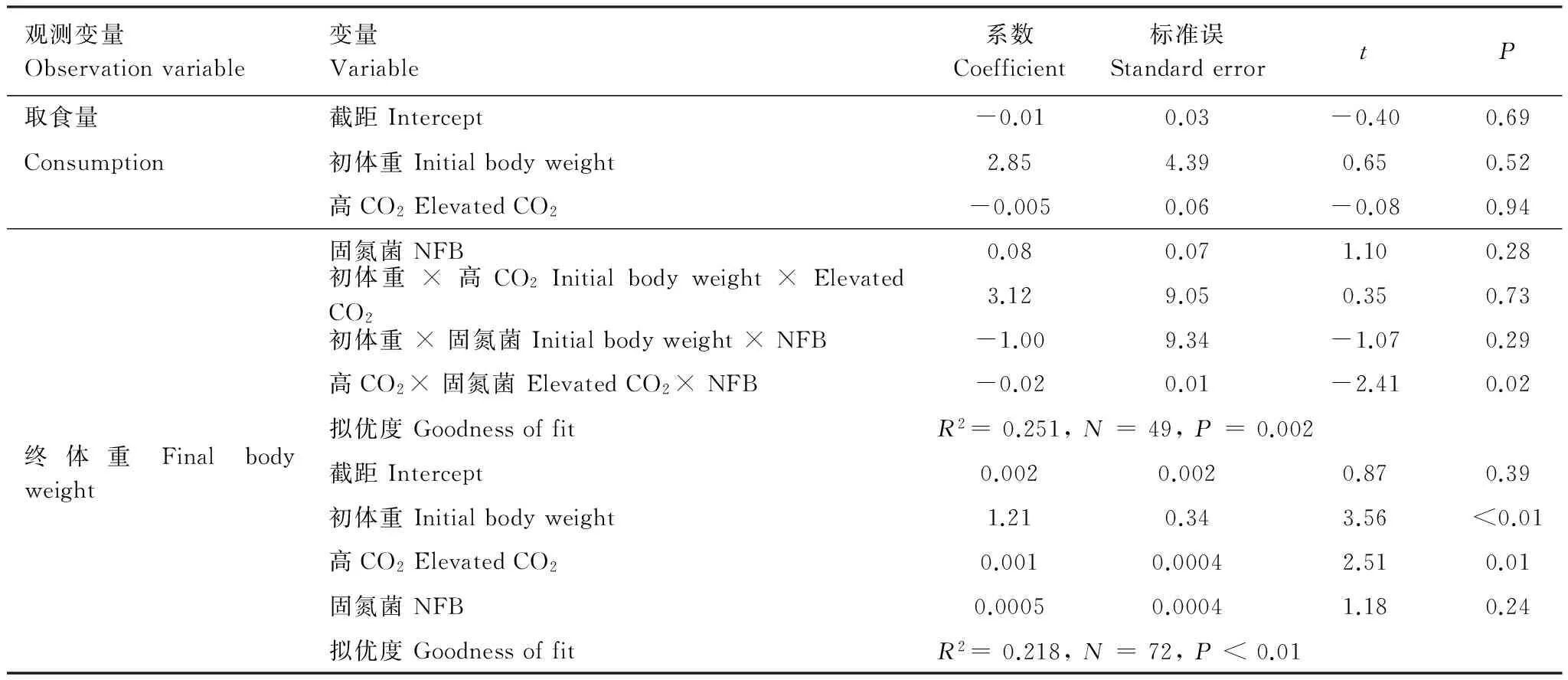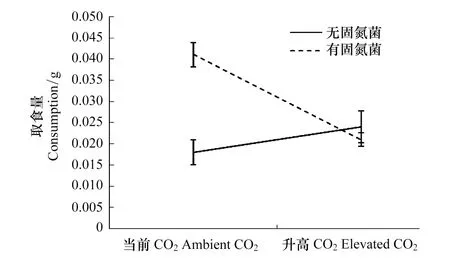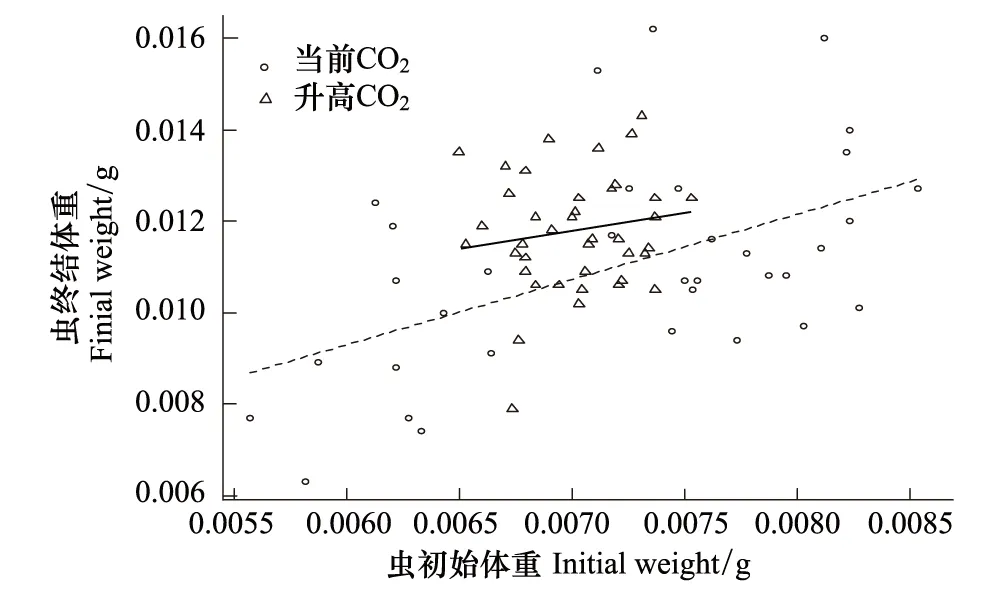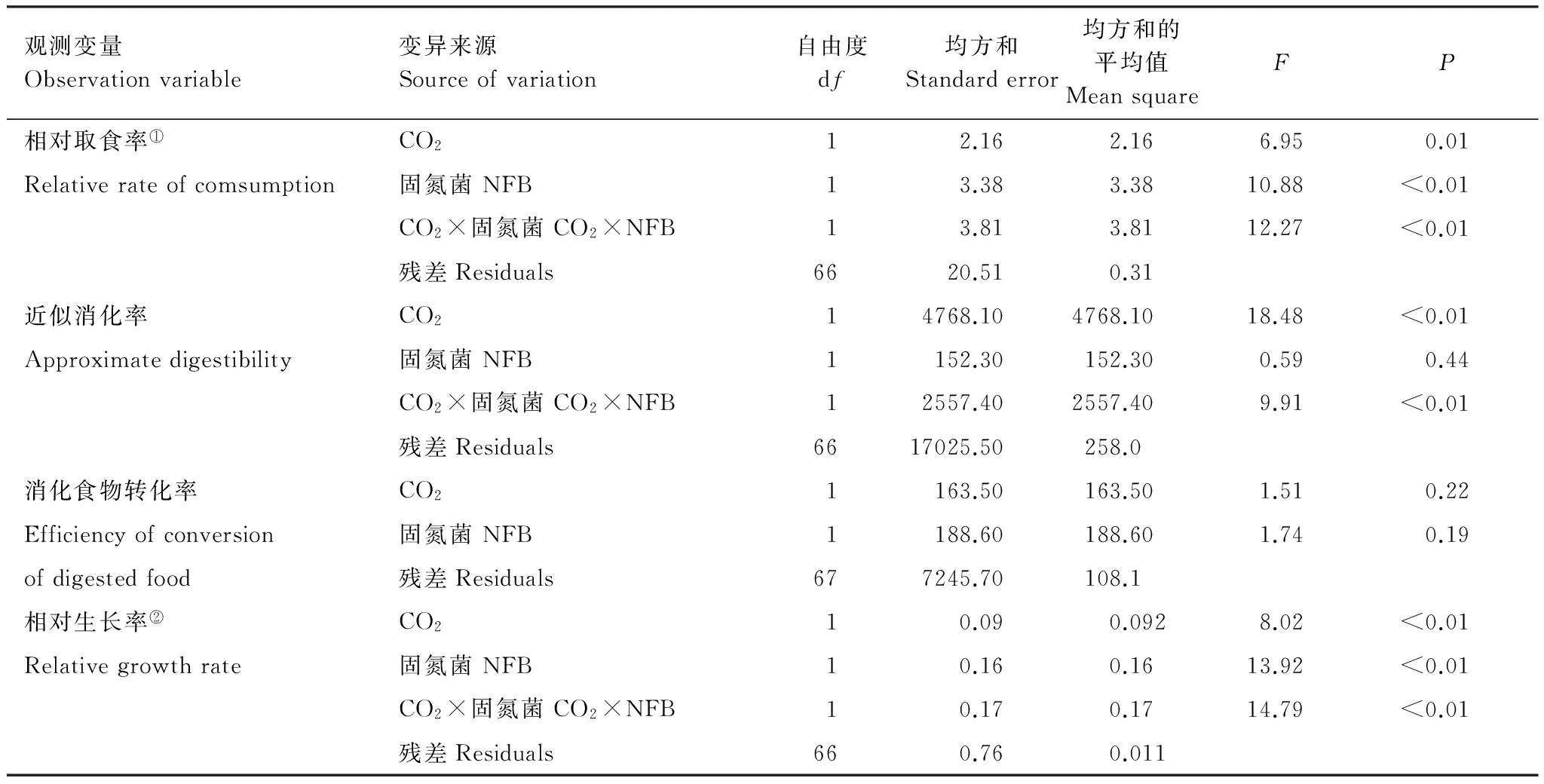高CO2浓度和固氮菌对斜纹夜蛾幼虫食物利用效率的影响
2015-03-10李保平
朱 敏,孟 玲,李保平
南京农业大学植物保护学院, 农作物生物灾害综合治理教育部重点实验室, 南京 210095
高CO2浓度和固氮菌对斜纹夜蛾幼虫食物利用效率的影响
朱 敏,孟 玲,李保平*
南京农业大学植物保护学院, 农作物生物灾害综合治理教育部重点实验室, 南京 210095
“补偿取食”假说认为CO2浓度升高后植食性昆虫会增大取食量以弥补植物组织中氮素营养的不足。但实证研究并非都支持该假说。用人工智能气候箱设置CO2浓度(390μL/L 和 780μL/L)和固氮菌(有、无)等2因素4处理,种植菜豆饲喂刚蜕皮进入4龄的斜纹夜蛾幼虫,测定其取食和食物利用效率。协方差分析结果表明,CO2浓度与固氮菌互作对斜纹夜蛾幼虫取食量具有显著影响,在无固氮菌处理下,斜纹夜蛾幼虫对高CO2浓度处理的菜豆取食量明显高于当前CO2浓度处理的;而在有固氮菌处理下,斜纹夜蛾幼虫对高CO2浓度下菜豆的取食量又比当前CO2浓度处理下的低。固氮菌对斜夜蛾4龄幼虫最终体重没有显著影响,但高CO2浓度处理的4龄幼虫终体重大于当前CO2浓度处理的幼虫。CO2浓度、固氮菌及其互作对斜纹夜蛾幼虫的相对取食率(RCR)和相对生长率(RGR)具有显著影响,在当前CO2浓度处理下,斜纹夜蛾4龄幼虫的RCR和RGR在有、无固氮菌处理之间没有显著差异;但在升高CO2浓度下,无固氮菌处理下的RCR和RGR显著大于有固氮菌处理。CO2浓度及其与固氮菌互作显著影响近似消化率(AD),在无固氮菌处理下,CO2浓度升高使AD增大;但在有固氮菌、CO2浓度升高下,其AD略有降低。CO2浓度和固氮菌双因素处理对消化食物转化率(ECD)无显著影响。研究结果支持“补偿取食”假说。
CO2浓度升高; 固氮菌; 食物利用; 害虫治理; 气候变化生物学
到本世纪末大气CO2浓度将会从当前水平的380μL/L升到500—750 μL/L[1],CO2浓度升高普遍促进植物光合作用[2- 3],降低叶片的氮含量和含水量,增加植物叶片的C/N[4- 6]。但植物对CO2浓度升高的响应在不同类植物间存在差异,非豆科C3植物的氮平均下降15%[7],而由于豆科植物固氮的总量在CO2浓度升高时会增加,豆科植物叶片的氮含量平均仅降低7%[8- 10]。在豆科作物和豆科牧草的试验中,CO2浓度升高下光合作用产物的可利用性增强,CO2浓度升高能有效刺激N2固定作用的假说已被广泛证实[11- 13]。CO2浓度升高下共生固氮菌固氮作用的相对增强能增加植物总氮量的结果在一系列研究中都有报道[14- 15]。如在自由大气CO2升高(FACE)条件下,大豆(Glycinemax)和三叶草(Trifoliumrepens)固氮作用增强,叶片的氮含量并未明显下降[11, 16- 17]。植物的氮含量能显著影响昆虫的取食行为[18- 21]。取食CO2浓度升高的叶片,植食昆虫一般会产生补偿性取食来弥补氮营养的不足,但同时会出现存活率下降和生长减缓的现象,即被称为“营养补偿假说”[22- 25]。由于CO2主要是通过改变植物的氮含量来作用于植食性昆虫,因此取食豆科植物的昆虫将会相对较少的受到CO2浓度升高带来的不利影响[26]。尽管豆科植物在生态和农业上均发挥着重要的作用,但仅有少量的研究涉及到CO2浓度升高对取食豆科昆虫的影响[27]。例如,尺蠖(Semiothisacinerearia)取食CO2浓度升高下大豆的生长率没有下降[6, 28];拟尺蠖(TrichoplusianiHubner)取食CO2浓度升高下未施肥的利马豆(Phaseoluslunatus)的生长率没有下降[29];但CO2浓度升高下百脉根三叶草(Lotuscorniculatus)对灰蝶(Coliasphilodice)幼虫有利[30];Karowe[4]研究表明,CO2浓度增加对豆科植物C/N比及C、N次生化合物变化的影响比非固氮C3植物小,取食高CO2浓度大豆叶片尺蠖的取食营养效应及发育特征与正常CO2浓度下相比差异均不显著。但迄今未见通过控制固氮菌来说明高CO2浓度下植物碳/氮比的变化对植食性昆虫的影响,而这样的试验可避免由于用不同植物进行比较而产生的背景条件不一致所造成的差异。
斜纹夜蛾(ProdenialituraFabricius)属间歇性猖獗的多食性和暴食性害虫,危害蔬菜以及粮食、经济作物等近100科300多种植物[31]。斜纹夜蛾危害损失率一般在10%—20%,严重的高达35%以上,导致大豆以及豆科主要蔬菜的产量下降,品质变差,影响农民收入的增加,制约了大豆等产业的发展[32- 33]。鉴于斜纹夜蛾的危害性及豆科植物及其植食者对CO2浓度升高响应的研究对农业和生态系统的重要性,本研究以斜纹夜蛾与寄主植物菜豆(Phaseolusvulgaris)为例,探讨了CO2浓度升高对豆科植食者相互作用关系的影响。假设在无固氮菌条件下,取食高CO2浓度下菜豆叶片的斜纹夜蛾的取食营养效应将会显著低于当前CO2浓度下;而在有固氮菌时,取食高CO2浓度下菜豆叶片的斜纹夜蛾取食营养效应将不会与当前CO2浓度下有显著差异。
1 材料与方法
1.1 试验材料
供试菜豆品种为‘江蔬81- 6号’,由江苏省农业科学研究院蔬菜研究所提供。菜豆野生型固氮菌(Rhizobiumetli)CFN42品系由南京农业大学生命科学学院微生物实验室提供。供试寄主斜纹夜蛾是2010年采自江苏省南京市浦口区大豆田,在养虫室(温度(24 ± 1)℃、光照14∶10h、RH 为(60±10)%)中用人工饲料繁殖多代的虫源。
1.2 培养液配方
Fahraeus无氮营养液[34](每升纯水):Na2HPO40.15g,KH2PO40.1g,MgSO4·7H2O 0.120 g,CaCl2·2H2O 0.1g,Fecitrate 0.005 g,pH 6.5;Gibson微量元素培养液[35](每L纯水):H2BO32.86 g,MnSO4·4H2O 2.03 g,ZnSO4·7H2O 0.22 g,CuSO4·5 H2O 0.08 g,Na2MoO4·2H2O 0.08g。试验中在每升 Fahraeus无氮营养液中滴入1mL Gibson微量元素培养液。
1.3 处理方法
1.3.1 菜豆培育方法
将萌发2 d的菜豆种子用0.6%的NaClO溶液消毒1 min,然后浸泡在稀释过的野生型固氮菌的菌悬液(浓度约1×107mL-1)中30 min(用作对照的种子用清水浸泡30 min),处理后在无菌条件下种植于加入上述营养液1 L,培养基为蛭石,直径为15cm的花盆中(花盆与蛭石已灭菌),然后将花盆置于不同处理的人工智能气候箱内(武汉瑞华HP300GS型)。实验条件为温度(25±1)℃、相对湿度60%—80%、光周期为L∶D=14∶10 (L:8:30—22:30; D:22:30—8:30)。实验设4个处理:无固氮菌+高CO2浓度(780μL/L),固氮菌+高CO2浓度,无固氮菌+当前CO2浓度(390μL/L),固氮菌+当前CO2浓度。每组各栽培20盆,每盆内种5株。试验期间各处理浇无菌水,且各处理每花盆每周浇1L的无菌营养液。
1.3.2 CO2浓度与固氮菌互作对斜纹夜蛾幼虫营养效应的影响
随机选取在人工饲料下饲养长至3龄末期的斜纹夜蛾幼虫共4组,每组50头,饥饿处理12 h后选择脱皮进入四龄幼虫各组35头,称量初始体重(预试验表明斜纹夜蛾从4龄开始进入暴食期)。将其中10头烘干称重,提供湿/干转换系数,估计处理幼虫的干重。每天称取各处理环境下的新鲜菜豆(固氮菌从侵染根系到结瘤需要2周,因此菜豆叶片3周后摘用)叶片若干投喂供试幼虫,且保证至少一半的叶片被取食,减少系统误差。且取同一处理环境下的新鲜菜豆叶片若干作为空白对照用来提供湿/干转换系数从而估计供试幼虫每天取食的叶片干重。每天更换新鲜菜豆叶片,且将每天幼虫取食后的剩余叶片、作为对照的叶片及幼虫的粪便置于60℃的恒温烘箱(森信公司,DGG- 9070A型)内烘24 h后称重(Mettler电子天平 AL204- 1C,万分之一精度)。连续进行3 d,最后1 d将试虫烘干称重记为终期体重(同上)。记录脱皮情况,若有脱皮或死亡则去除该重复。
斜纹夜蛾幼虫的营养效应指标采用4个营养利用指标,相对生长率 (RGR) 、 相对取食率 (RCR) 、近似消化率(AD)和消化食物转化率(ECD)[36]。
1.4 数据分析
经典的基于比率食物利用效率指数存在诸多弊病,而协方差分析具有很多优势[37]。运用协方差分析,以试虫初始体重为协变量,比较CO2浓度和固氮菌处理对斜纹夜蛾幼虫体重及取食量的影响。为了与此前的相关研究进行比较,仍运用经典的基于比率的食物利用效率指数进行分析,数据分析前先进行适当的数据转换,以满足方差分析的要求(正态分布和方差整齐)。其中对RGR进行先平方根再反正弦转换, 对RCR进行自然对数转换。用R统计分析软件分析数据[38]。
2 结果与分析
2.1 CO2与固氮菌对斜纹夜蛾幼虫取食量与体增重的影响
一般线性模型分析表明,CO2浓度与固氮菌对斜纹夜蛾幼虫取食量均无显著影响,但二者存在显著互作影响(表1)。在无固氮菌处理下,高CO2浓度下斜纹夜蛾幼虫的取食量要明显高于当前CO2浓度处理下的;而在有固氮菌处理下,高CO2浓度下斜纹夜蛾幼虫取食量又比当前CO2浓度处理下的低(图1)。同时CO2浓度对斜夜蛾幼虫终期体重影响显著,但固氮菌没有显著影响(表1),高CO2浓度下斜纹夜蛾幼虫终期体重显著大于当前CO2浓度处理下的(图2)。
2.2 CO2浓度和固氮菌对斜纹夜蛾幼虫食物利用效率的影响
CO2浓度、固氮菌及其互作对斜纹夜蛾幼虫的相对取食率(RCR)和相对生长率(RGR)具有显著影响(表2),在当前CO2浓度下,斜纹夜蛾4龄幼虫的RCR和RGR在有与无固氮菌处理之间没有显著差异;但在CO2浓度升高下,无固氮菌处理下的RCR和RGR显著大于有固氮菌处理(图3)。CO2浓度及其与固氮菌互作显著影响近似消化率(AD) (表2),在无固氮菌处理下,CO2浓度升高使AD增大;但在有固氮菌时,CO2浓度升高使AD略有下降(图3)。CO2浓度和固氮菌对消化食物转化率(ECD)没有显著影响(图3)。
表1 拟合CO2浓度和固氮菌处理影响斜纹夜蛾叶片取食量和体增重的一般线性模型参数
Table 1 Parameters of the simple linear model fit to consumption and finial body weight as affected by CO2and NFB treatments inP.litura

观测变量Observationvariable变量Variable系数Coefficient标准误StandarderrortP取食量截距Intercept-0.010.03-0.400.69Consumption初体重Initialbodyweight2.854.390.650.52高CO2ElevatedCO2-0.0050.06-0.080.94固氮菌NFB0.080.071.100.28初体重×高CO2Initialbodyweight×ElevatedCO23.129.050.350.73初体重×固氮菌Initialbodyweight×NFB-1.009.34-1.070.29高CO2×固氮菌ElevatedCO2×NFB-0.020.01-2.410.02拟优度GoodnessoffitR2=0.251,N=49,P=0.002终体重Finalbodyweight截距Intercept0.0020.0020.870.39初体重Initialbodyweight1.210.343.56<0.01高CO2ElevatedCO20.0010.00042.510.01固氮菌NFB0.00050.00041.180.24拟优度GoodnessoffitR2=0.218,N=72,P<0.01

图1 CO2浓度和固氮菌对斜纹夜蛾幼虫取食率的影响 Fig.1 Effects of CO2 and NFB on consumption in the 4th instar larva of P. litura短柄代表平均值的标准误 Bars are the standard error of the mean

图2 CO2浓度和NFB对斜纹夜蛾4龄幼虫体重的影响 Fig.2 Effects of CO2 and NFB on body weight in the 4th instar larva of P. litura虚线代表当前CO2浓度处理 The dotted line is the ambient CO2 treatment; 实线代表升高CO2处理The solid line is the elevated CO2 treatment
3 讨论
相对生长率(RGR)是衡量试验因子对植食性昆虫体重增加和发育时间的重要综合评价指标[26],RGR越大,说明植食性昆虫在短时间内能将消化的食物转化成自身营养的能力越强,生长发育越好。本研究结果表明CO2浓度与固氮菌均显著互作于斜纹夜蛾的RGR。在无氮菌处理下,高CO2浓度处理下斜纹夜蛾幼虫取食更多的叶片,对叶片的消化能力增强,即相对取食消耗率(RCR)、近似消化率(AD)显著增高,虽然食物转化率(ECD)差异不明显,即取食高CO2浓度下更多叶片的幼虫并没有最大限度的将吸收的营养转化为体重,但幼虫的RGR更大,仍然可以得出以下结论:在无固氮菌条件下取食高CO2浓度下生长的菜豆叶片的幼虫取食量增加,营养利用效率更高,高CO2浓度对斜纹夜蛾发生更有利。相反,在有固氮菌处理下,高CO2浓度对斜纹夜蛾的影响与当前CO2浓度处理下对斜纹夜蛾的RGR影响并不显著。高CO2浓度下斜纹夜蛾取食菜豆叶片的量下降,但对消化叶片的吸收也略高,幼虫RGR下降的并不明显,高CO2浓度处理并未显著改变斜纹夜蛾的食物营养利用效率。

表2 CO2浓度和固氮菌互作对斜纹夜蛾食物利用效率影响的方差分析结果Table 2 ANOVA results for effects of different CO2 and NFB treatments on food utilization parameters of P.litura
① 经反正玄平方根转换 Data were arcsine square root transformation; ② 经自然对数转换 Data were natural log transformation

图3 CO2浓度和NFB对斜纹夜蛾幼虫食物利用效率的影响Fig.3 Effects of CO2 and NFB on food utilization efficiency of P. litura larvae
本试验的结果与Karowe[26]的结果一致,即由于豆科植物可以利用固氮菌固氮的特征,在CO2浓度升高下,取食豆科植物的植食性昆虫相比于取食非豆科植物的植食性昆虫营养的改变要小得多。前人研究结果表明取食CO2浓度升高下美国山杨舞毒蛾(Lymantriadispar)幼虫RGR降低63%,森林天幕毛虫(MalacosomaneustriatestaceaMotsch)的RGR下降25%[23];舞毒蛾(L.dispar)幼虫取食CO2升高下无梗花栎(Quercuspetraea)时,RGR降低30%[9]。取食山艾(Vacciniumuliginosum)的异黑蝗(Melanoplusdifferentialis)在CO2浓度升高下(650 μL/L)RGR降低40%[39]。而本试验中有固氮菌处理下,高CO2浓度下斜纹夜蛾幼虫的RGR仅仅下降13%,与当前CO2浓度处理差异并不显著,而在无固氮菌条件下, CO2浓度升高更有利斜纹夜蛾幼虫的发生,这与先前许多研究CO2浓度升高对取食非豆科C3植物的植食者营养效率的结果不太一致[40]。究其原因可能是在无法固氮时,CO2浓度升高下菜豆植物的C/N比发生改变,特别是含氮的次生化合物如蛋白酶抑制剂的减少造成的。如Zavala[13]研究表明在CO2浓度升高(大豆FACE系统)下日本金龟甲(Popilliajaponica)取食大豆叶片的量大大增加,原因是CO2浓度升高大豆蛋白酶抑制剂表达量的下降,更有利于甲虫的取食,同时叶片糖分的增加也促进甲虫取食。当然本试验仅是推测,还需要后续验证。
本试验仅研究了高CO2浓度与固氮菌处理对斜纹夜蛾幼虫单个龄期的影响,处理的时间比较短,而已有的CO2浓度升高对取食非豆科植物的鳞翅目昆虫的影响大都研究了昆虫的整个生活史特征,甚至是不同代数下的[41],而且不同的昆虫对不同的植物的取食生活史特征也可能会不同[26]。因此下一步可以研究CO2浓度升高对取食豆科植物的昆虫多个世代的响应或取食豆科植物与非豆科植物的同一植食昆虫(或亲缘关系比较近的昆虫)对CO2浓度升高的的响应。
致谢:南京农业大学生命科学学院钟曾涛和凌军提供固氮菌菌株,植物保护学院程峰、卢笛、王以一等对试验给予帮助,特此致谢。
[1] Raper S. Climate modelling: IPCC gazes into the future. Nature Climate Change, 2012, 2(4): 232- 233.
[2] Curtis P S, Wang X. A meta-analysis of elevated CO2effects on woody plant mass, form, and physiology. Oecologia, 1998, 113(3): 299- 313.
[3] Poorter H, Navas M L. Plant growth and competition at elevated CO2: on winners, losers and functional groups. New Phytologist, 2003, 157(2): 175- 198.
[4] Karowe D N, Seimens D H, Mitchell-Olds T. Species-specific response of glucosinolate content to elevated atmospheric CO2. Journal of Chemical Ecology, 1997, 23(11): 2569- 2582.
[5] Körner C. Plant CO2responses: an issue of definition, time and resource supply. New Phytologist, 2006, 172(3): 393- 411.
[6] Lincoln D, Sionit N, Strain B. Growth and feeding response ofPseudoplusiaincludens(Lepidoptera: Noctuidae) to host plants grown in controlled carbon dioxide atmospheres. Environmental Entomology, 1984, 13(6): 1527- 1530.
[7] Cotrufo M F, Ineson P, Scott A. Elevated CO2reduces the nitrogen concentration of plant tissues. Global Change Biology, 2002, 4(1): 43- 54.
[8] Edwards E J, McCaffery S, Evans J R. Phosphorus availability and elevated CO2affect biological nitrogen fixation and nutrient fluxes in a clover-dominated sward. New Phytologist, 2005, 169(1): 157- 167.
[9] Hättenschwiler S, Schafellner C. Gypsy moth feeding in the canopy of a CO2-enriched mature forest. Global Change Biology, 2004, 10(11): 1899- 1908.
[10] Vogel C S, Curtis P S, Thomas R B. Growth and nitrogen accretion of dinitrogen-fixingAlnusglutinosa(L.) Gaertn. under elevated carbon dioxide. Plant Ecology, 1997, 130(1): 63- 70.
[11] Rogers A, Allen D, Davey P, Morgan P, Ainsworth E A, Bernacchi C J, Cornic G, Dermody O, Dohleman F G, Heaton E A, Mahoney J, Zhu X G, Delucia E H, Ort D R, Long S P. Leaf photosynthesis and carbohydrate dynamics of soybeans grown throughout their life-cycle under free-air carbon dioxide enrichment. Plant, Cell & Environment, 2004, 27(4): 449- 458.
[12] Soussana J, Hartwig U. The effects of elevated CO2on symbiotic N2fixation: a link between the carbon and nitrogen cycles in grassland ecosystems. Plant and Soil, 1995, 187(2): 321- 332.
[13] Zavala J A, Casteel C L, DeLucia E H, Berenbaum M R. Anthropogenic increase in carbon dioxide compromises plant defense against invasive insects. Proceedings of the National Academy of Sciences, 2008, 105(13): 5129- 5133.
[14] Ainsworth E A, Long S P. What have we learned from 15 years of free-air CO2enrichment (FACE)? A meta-analytic review of the responses of photosynthesis, canopy properties and plant production to rising CO2. New Phytologist, 2004, 165(2): 351- 372.
[15] Leakey A D, Ainsworth E A, Bernacchi C J, Rogers A, Long S P, Ort D R. Elevated CO2effects on plant carbon, nitrogen, and water relations: six important lessons from FACE. Journal of Experimental Botany, 2009, 60(10): 2859- 2876.
[16] Lee T D, Tjoelker M G, Reich P B, Russelle M P. Contrasting growth response of an N2-fixing and non-fixing forb to elevated CO2: dependence on soil N supply. Plant and Soil, 2003, 255(2): 475- 486.
[17] Schortemeyer M, Atkin O, McFarlane N, Evans J R. N2fixation by Acacia species increases under elevated atmospheric CO2. Plant, Cell & Environment, 2002, 25(4): 567- 579.
[18] Scriber J M, Feeny P. Growth of herbivorous caterpillars in relation to feeding specialization and to the growth form of their food plants. Ecology, 1979, 60(4): 829- 850.
[19] Mattson W J Jr. Herbivory in relation to plant nitrogen content. Annual Review of Ecology and Systematics, 1980: 119- 161.
[20] Scriber J, Slansky F Jr. The nutritional ecology of immature insects. Annual Review of Entomology, 1981, 26(1): 183- 211.
[21] Karowe, D N, Martin, M. M. The effects of quantity and quality of diet nitrogen on the growth, efficiency of food utilization, nitrogen budget, and metabolic rate of fifth-instaSpodopteraeridanialarvae (Lepidoptera: Noctuidae). Journal of Insect Physiology 1989,35(9), 699- 708.
[22] Fajer E D, Bowers M D, Bazzaz F A. The effects of enriched carbon dioxide atmospheres on plant-insect herbivore interactions. Science, 1989, 243(4895): 1198- 1200.
[23] Lindroth R L, Kinney K K, Platz C L. Responses of diciduous trees to elevated atmospheric CO2: productivity, phytochemistry, and insect performance. Ecology, 1993, 74(3): 763- 777.
[24] Chen F, Wu G, Ge F, Parajulee M N, Shrestha R B. Effects of elevated CO2and transgenic Bt cotton on plant chemistry, performance, and feeding of an insect herbivore, the cotton bollworm. Entomologia Experimentalis et Applicata, 2005, 115(2): 341- 350.
[25] Zvereva E, Kozlov M. Consequences of simultaneous elevation of carbon dioxide and temperature for plant-herbivore interactions: a metaanalysis. Global Change Biology, 2005, 12(1): 27- 41.
[26] Karowe D N. Are legume-feeding herbivores buffered against direct effects of elevated carbon dioxide on host plants? A test with the sulfur butterfly,Coliasphilodice. Global Change Biology, 2007, 13(10): 2045- 2051.
[27] Rogers A, Ainsworth E A, Leakey A D. Will elevated carbon dioxide concentration amplify the benefits of nitrogen fixation in legumes? Plant Physiology, 2009, 151(3): 1009- 1016.
[28] Lincoln D, Couvet D, Sionit N. Response of an insect herbivore to host plants grown in carbon dioxide enriched atmospheres. Oecologia, 1986, 69(4): 556- 560.
[29] Osbrink W L, Trumble J T, Wagner R E. Host suitability ofPhaseoluslunataforTrichoplusiani(Lepidoptera: Noctuidae) in controlled carbon dioxide atmospheres. Environmental Entomology, 1987, 16(3): 639- 644.
[30] Goverde M, Erhardt A, Stöcklin J. Genotype-specific response of a lycaenid herbivore to elevated carbon dioxide and phosphorus availability in calcareous grassland. Oecologia, 2004, 139(3): 383- 391.
[31] 洪晓月, 丁锦华. 农业昆虫学 (第二版). 北京: 中国农业出版社, 2007.
[32] 陈庭华, 陈彩霞, 蒋开杰, 宋挺跃, 吴海军. 斜纹夜蛾发生规律和预测预报新方法. 昆虫知识, 2001, 38(1): 36- 39.
[33] 秦厚国, 叶正襄, 黄水金, 丁建, 罗任华. 不同寄主植物与斜纹夜蛾喜食程度、生长发育及存活率的关系研究. 中国生态农业学报, 2004, 12(2): 40- 42.
[34] Fahraeus G. The infection of clover root hairs by nodule bacteria studied by a simple glass slide technique. Journal of General Microbiology, 1957, 16(2): 374- 381.
[35] Gibson A. Physical environment and symbiotic nitrogen fixation. Australian Journal of Biological Sciences, 1963, 16(1): 28- 42.
[36] Waldbauer G P. The consumption and utilization of food by insects. Advances in Insect Physiology, 1968, 5: 229- 288.
[37] Raubenheimer D, Simpson S J. Analysis of covariance: an alternative to nutritional indices. Entomologia Experimentalis et Applicata, 1992, 62(3): 221- 231.
[38] R Development Core Team. R A language and environment for statistical computing. R Foundation for Statistical Computing, Vienna, Austria, 2007. ISBN 3- 900051-07-0, URL. [2009- 5- 31]. http://www.R-project.org.
[39] Stiling P, Cornelissen T. How does elevated carbon dioxide (CO2) affect plant-herbivore interactions? A field experiment and meta-analysis of CO-2-mediated changes on plant chemistry and herbivore performance. Global Change Biology, 2007, 13(9): 1823- 1842.
[40] Asshoff R, Hättenschwiler S. Growth and reproduction of the alpine grasshopperMiramellaalpinafeeding on CO2-enriched dwarf shrubs at treeline. Oecologia, 2005, 142(2): 191- 201.
[41] Chen F J, Wu G, Parajulee M N, Ge F. Long-term impacts of elevated carbon dioxide and transgenic Bt cotton on performance and feeding of three generations of cotton bollworm. Entomologia Experimentalis et Applicata, 2007, 124(1): 27- 35.
Effects of elevated CO2and nitrogen-fixing bacteria on food utilization efficiency inProdenialituraFabricius (Lepidoptera: Noctuidae)
ZHU Min, MENG Ling, LI Baoping*
DepartmentofEntomology,NanjingAgriculturalUniversity;AgriculturalPestsManagementLaboratoryofMinistryofEducation,Nanjing210095,China
The “compensatory feeding hypothesis” proposes that herbivorous insects may increase their plant consumption to compensate for the deficiency of Nitrogen in the plant tissue consumed under elevated CO2concentration. The empirical studies however are not overall in line with this prediction. In this study laboratory trails were conducted in growth chambers by manipulating CO2concentration (390μL/L, 780μL/L) and the nitrogen-fixing bacteria (NFB) (with, without) for the common beanPhaseolusvulgarisin a factorial design.Prodenialituralarvae at the 4thstadium were fed with the bean plants cultured in aforementioned treatments, and testedfor food consumption and utilization. ANCOVA results showed that CO2and NFB had significant effects both independently and in interaction on the 4thinstar larva in relative consumption (RCR) and relative growth rate (RGR). Under ambient CO2there were no differences in RCR and RGR between NFB treatments, but in elevated CO2RCR and RGR increased in the absence as opposed to the presence of NFB. CO2and its interaction with NFB had significant influence on approximate digestibility (AD), where AD increased in elevated CO2as opposed to ambient CO2in the absence of NFB but slightly reduced in the presence of NFB. CO2and NFB treatments did not influence efficiency of conversion of ingested food (ECI). The results of this study lend support for the prediction of the compensatory feeding hypothesis.
elevated CO2; nitrogen-fixing bacteria; food utilization; pest management; climate change biology
国家公益性行业(农业)科研专项(200903003, 201103032)
2013- 03- 25;
日期:2014- 03- 25
10.5846/stxb201303250507
*通讯作者Corresponding author.E-mail: lbp@njau.edu.cn
朱敏,孟玲,李保平.高CO2浓度和固氮菌对斜纹夜蛾幼虫食物利用效率的影响.生态学报,2015,35(2):333- 339.
Zhu M, Meng L, Li B P.Effects of elevated CO2and nitrogen-fixing bacteria on food utilization efficiency inProdenialituraFabricius (Lepidoptera: Noctuidae).Acta Ecologica Sinica,2015,35(2):333- 339.
